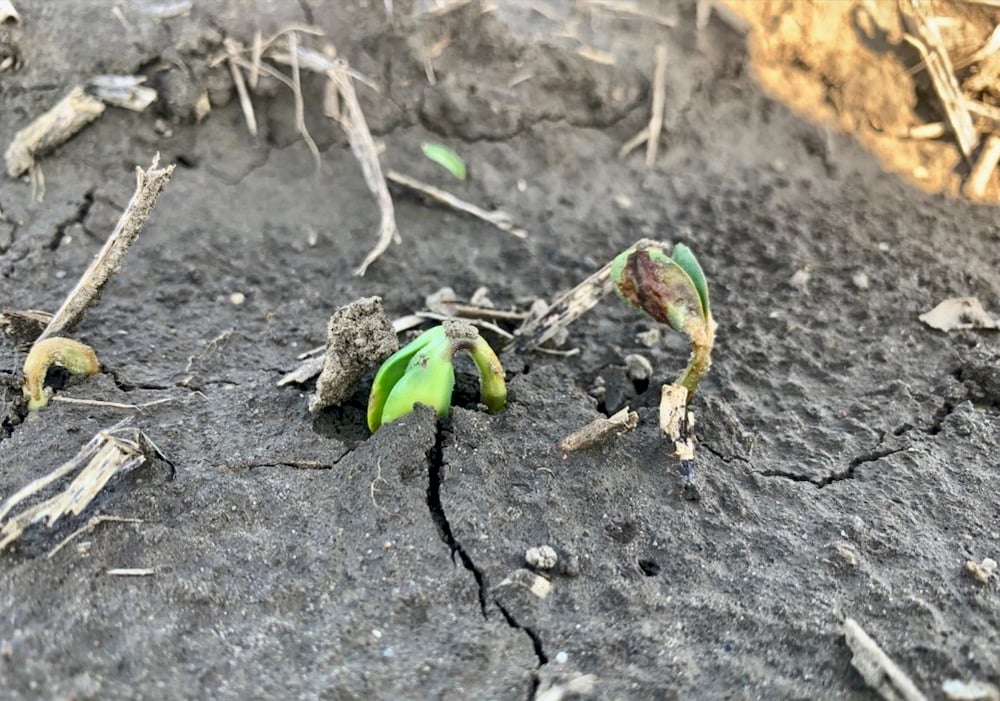Corn planting nears completion, first cut alfalfa begins

Field Conditions
Read Also


Rob Flack new Ontario agriculture minister
Rob Flack, MPP for Elgin-Middlesex-London has been announced as Ontario’s new Minister of Farming, Agriculture, and Agribusiness. Lisa Thompson, former…
Significant planting progress has been made in many areas across the province over the last two weeks. Some growers were able to wrap up their corn, soybean and edible bean planting and apply their T3 fungicide applications in wheat. However, those on heavier soils or those who have received persistent rainfall, have not been able to finish planting or in some cases even start.
Corn
Corn planting is estimated to be 95 per cent complete across the province, although this number is estimated to be much lower on heavier soils or areas with persistent rainfall. Corn populations have been reported as being good; however, there are some fields that are sporadic due to crusting on the soil surface. There are also some fields showing signs of sidewall compaction and uneven stands due to less-than-ideal conditions at planting. Overall, there have been few corn replants to date.
For the most part, growers continue to make timely herbicide applications. Sidedressing is yet to begin but growers are encouraged to conduct a Pre-Sidedress Nitrate Test (PSNT) to get an estimate of the amount of nitrogen available.
Early fungicide applications are not warranted for tar spot in corn and application timing needs to occur close to the onset of the epidemic. This can vary from year-to-year and by location. It is best to use scouting and/or decision support tools like the Field Prophet app to make informed decisions. In most years, a fungicide application will not be needed prior to the VT/R1 growth stage, even in years when tar spot has been yield limiting.
Soybeans
Generally, soybean plant stands have been good but planting progress continues to be variable across the province with some areas being up to 90 per cent complete while others on heavier soils are less than 30 per cent complete. There have been some replanted acres reported to date, particularly in those fields that were planted in less-than-ideal soil conditions with more anticipated poor emergence soil conditions due to soil surface crusting. There have also been reports of Group 14 herbicide damage (figure 1 at top), as well as seed corn maggot and slug feeding in some fields.
Those intending to plant winter wheat this fall but have not yet seeded their soybeans should consider switching to shorter season soybean varieties. Switching to a variety that is half a maturity group less should be sufficient to allow for timely winter wheat seeding. If winter wheat is not being seeded this fall, there is no need to switch to shorter season varieties until the end of June. If soybean planting continues to be delayed until June 10th the seeding rate should be increased by 10 per cent.
Growers who were unable to apply a preemergence herbicide in IP soybeans have limited options, some of which, like imazethapyr (Pursuit) will have rotational crop restrictions. It will be important to flag these fields for future crop planning, so that a sensitive crop is not planted during a herbicide’s plant back interval. Pesticide applicators are encouraged to continue their use of best practices to prevent off target drift. A new resource at www.bedriftaware.ca serves as a repository for best practices. .
Some growers who were not able to roll their beans prior to emergence are looking to roll after emergence. Ontario research has shown that rolling soybeans at the first trifoliate resulted in an average yield increase of 1 bu/ac, likely from better harvestability. If rolling soybeans after emergence they must be at least at the unifoliate stage and no more than 3rd trifoliate. Ideally, aim for the 1st trifoliate. Rolling should only be done with a smooth roller and and completed on a warm afternoon when plants are more flexible. Damage can still occur, particularly along the tractor tires but generally does not impact yields.
Cereals
Winter wheat continues to progress ahead of normal and yield potential continues to remain strong. With cooler nighttime temperatures, the grain fill period is expected to be long providing an opportunity for excellent yield potential. Much of the winter wheat crop has flowered with the latest fields expected to flower this week.
Compared to previous years many fields received a T3 fungicide application for the protection against fusarium head blight and DON. Many growers applied a T3 fungicide to also protect against stripe rust which has also been recently reported in Durham and into eastern Ontario. Stripe rust has been very field specific and growers are encouraged to continue to monitor those fields. Varieties differ in tolerance to stripe rust and new races of the fungal pathogen are constantly developing. Stripe rust samples are being collected and sent to USDA in Washington State for race typing. This will help determine the effectiveness of stripe rust resistance genes and plan for future variety development. Although many fields received a T3 application, many of the applications were delayed due to persistent wet conditions during the application window. While not within the ideal application window, research through the U.S. Scab Initiative has demonstrated that applications made as late as 5 to 7 days after flowering still resulted in a reduction in DON and greater protection against leaf diseases compared to early applications (heading).
Cereal leaf beetle (CLB) and true armyworm (TAW) have been reported in areas in southern and eastern Ontario. For the most part, thresholds continue to be low; however, some fields in Sombra, Petrolia, Arva/Thorndale and Seaforth areas have reached or passed thresholds and have require[M(5] [FJ(6] d control. Winter and spring cereals should continue to be monitored closely. More information on CLB and TAW thresholds and control options can be found here.
With the warm daytime and cold nighttime temperatures, some fields progressed quickly through the heading stages resulting in head snag. Some winter wheat varieties are more prone to head snag than others, but the yield impact should be minimal. There have also been reports of some winter wheat and winter barley fields lodging.
Forages
First cut alfalfa has begun, but most of it has not yet flowered. Alfalfa weevil continues to be challenging in fields in southern Ontario. Some fields have reached threshold and have required control. In eastern Ontario, new seeding stands are at threshold for potato leafhoppers and will need control. Established fields at threshold can likely be managed with cutting. More information on alfalfa pests can be found on Ontario CropIPM. Despite challenges in some alfalfa fields, forage yields to date have been well above average with some growers reporting first cut yields are 50 per cent above their average.
Edible Beans
Significant progress has been made on edible bean planting along with pre-emergence herbicide application. Edible bean planting is anticipated to be completed over the coming weeks. With the recent rainfall growers should watch for crusting and be prepared to address it.
Canola
Winter canola bloom is complete, and the crop is looking healthy overall. Specialists continue to monitor pest pressure (e.g., blister beetles and cabbage seed pod weevil).
Grub Injury in Some Crops
Grub injury is starting to be found in corn and forage stands this week. Given the extended planting season following a mild winter, grub larvae have been actively feeding longer than usual. Though most of these larvae will be done feeding soon to pupate and become adults, it is very important to identify which species and stage of larvae are present in the field to better understand their life cycle and crop protection needs for this fall or following spring. Annual grubs like European chafer and Japanese beetle lay their eggs in late summer which leads to small first instar larvae feeding in these fields on any fall seeded crops. June beetle grubs, on the other hand, have a three-year life cycle. If larvae are in their second year, feeding will continue all season and later planted spring crops like soybeans or perennial crops risk seeing injury. If the larvae are in their third year already, feeding will be finished soon and focus needs to be on plans for which crop are intended to be planted in those fields this fall or next spring to ensure there is protection on the seed, where possible, to avoid crop loss. More information on grubs can be found on Ontario CropIPM.
Agricorp
Replants are starting to gain traction with 21,000 damage reports in soybeans being reported to date (as of June 4, 2024). The majority of damage reports are from Lambton County.
For Production Insurance coverage, crop planting deadlines are June 15 for corn, and June 30th for soybeans. The deadline for reporting unseeded acreage is June 15. The deadline for reporting actual acres of spring-seeded grains and oilseeds or new forages is June 30th. The unseeded acreage benefit provides one-third of a farms average farm yield if a crop is not planted by the planting deadline. Growers are encouraged to report acres as soon as possible to avoid busy times at the deadline.
Mental Health Resources for Agriculture Community
Given the challenging spring planting conditions, the agriculture community is encouraged to reach out to your neighbours, friends and family to check in on them and their well-being. If you or someone you know is struggling, please consider reaching out to any of the following resources:
- Farmer Wellness Initiative which provides access to mental health support 365/24/7 in both English and French at 1-888-267-6255.
- Connexontario (English) (French) provides service information for people experiencing problems with mental health, gambling, drugs or alcohol. Helpful, supportive system navigation specialists answer all calls (1-866-531-2600), email or web chat requests 24/7, the service is free and confidential.
- In The Know is a mental health literacy program for farmers and the agricultural community. For more information contact the Program Coordinator, Rebecca Posthumus at [email protected] or call Toll Free: 1-800-875-6213.
– To read the full Ontario Crop Report for June 6, visit the Field Crop News website.
Source: Farmtario.com

